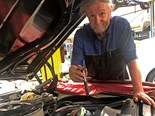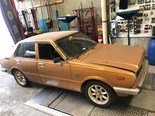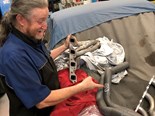Roadworthy certificates and generosity - Mick's Workshop
Mick is toiling away in the workshop and providing you with the car advice you need

|
|
Mick is busy in the workshop as always
|
Have you had a roadworthy done lately? They’ve become an increasingly-complex minefield in recent years, with differences from state to state.
Obviously I work out of Victoria and our rules are among the most demanding. It costs money to have a mechanic check over the car and, though it’s not rocket science, it can be lengthy and costly.
Most things you can check beforehand at home, things like engine or transmission leaks that need fixing, torn seat covers, and making sure the electrics work.
Add in crook tyres, wobbles in the steering or suspect brakes and there’s a lot you can eyeball before you can take it in.
On older cars, there are a lot of things you can do yourself as part of the prep. What you’re aiming to do is minimize the surprises and the workshop bill. If you go through it methodically and in no great hurry, you can keep your costs down.
As for why RWCs have become pricey, well, there is a lot to cover. In Victoria there is a lot of responsibility thrown on the tester. You need to attend expensive courses and obtain new equipment to run their systems. Those costs need to be passed on.
Making life more confusing is there is no standard set for pricing and the time required, so that’s up to each workshop.
Once you roll your car in, we have to photograph it thoroughly and get it up on the hoist. All four wheels have to come off as part of the process. Then it needs to be road-tested, with evidence supplied that it’s happened (which means you need to have a working odometer!).
Under the current rules, there is a solid two hours of labour involved. Workshop rates are around $120-150 per hour, so you can see how it adds up.
Weirdly, though, we have no authority to pull an unsafe vehicle off the road even though we can refuse a roadworthy certificate.
Meanwhile the great international parts shortage continues to catch us out. The latest victim is a 2010 Honda CRV belonging to a customer and we are struggling to find door rubbers.
Honda lists them as no longer available, that is obsolete! For a 2010 car – really? Now that’s a roadworthy requirement…
And now for some advice to my fellow workshop owners: Don’t be afraid to take on work experience kids, but interview them first.
We want this next generation to come along, but I like to make sure they have some understanding and commitment before taking them on.
With some people, they just don’t have it in them, and every now and then you strike someone who does. So welcome, Grady, our latest resident, whose Dad is a Unique Cars mag reader.
Oh, and a shout-out to Jack from Inverleigh (Vic), who is helping us immensely in finding parts for the lovely 1949 in the workshop. He’s been incredibly generous and it’s great to know there are still enthusiasts out there like him.
BENZ BROTHER
Hi Mick. I have a Mercedes-Benz W124 E300, so that’s the straight six 3.0lt M103 engine.
Given it cost a pittance, it’s been a great car. Comfortable, quiet, solid, just a really good thing to get around in.
However we’ve recently had a bit of an issue where it can idle very rough, as if a couple of cylinders aren’t playing. That can get worse when you try to take off at the lights, to the point where I’ve had it stall a couple of times.
It doesn’t happen every time I drive it, and seems to be worse when the car has been sitting for a week or more. It’s serviced regularly, has had the fuel pump and filter replaced recently and is in good general shape. Any theories?
David Russell
Mick says...
A Benz from the ‘bank vault’ era. People love them and they have a few fans among the Unique Cars mag crew. A good one is a joy and a bad one will bite you on the wallet.
In your case, check the basics first: All your electrical connectors are solid, vacuum lines are in good shape. We had another similar case recently on an S class of about the same vintage and it proved to be suspect battery terminals and a loose earth at an engine mount.
If the basics check out, the most common problem with modern cars (and I count that as one) is the throttle body gets filthy. The only thing you have to be careful of is whether it has a throttle cable or fly-by-wire.
Cable actuation is really easy to do. If it’s by wire you cannot manually open the butterfly. If you force it open to clean it you will break it. You can still clean it, but have to be very gentle and meticulous.
Once you’ve cleaned it, you should be able to hold it up to the light and see a nice ‘halo’ around the butterfly valve. All engines need that little bit of air getting through to start and idle.
COOL XB
Hi there. I’ve had an XB Falcon wagon for about five years now. It doesn’t do a lot of work – more of a weekender drive – and I’m wondering what do with it next.
The engine (a 302 with auto) has about 100,000km since top-end rebuild and seems okay. Nothing special, but it’s reliable. But the radiator is on the way out and needs to be replaced. So I’m wondering how far to go.
Should I use this as an excuse for another engine freshen-up, or just tackle the cooling? And what sort of radiator? Love your work.
Barry Smith
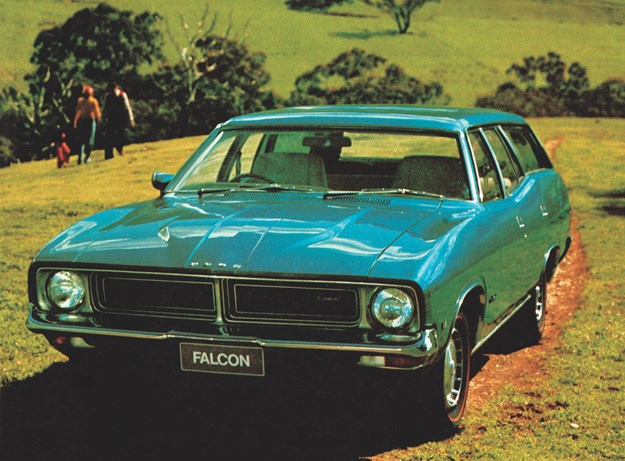 |
| Mick reckons an XB with a 302 is a fabulous thing. |
Mick says...
With the engine and driveline, you get my stock advice, which is if it ain’t broke, don’t fix it! Really, that’s a great cruiser package and I’d leave well alone as chances are you won’t gain a great deal and the 302 will probably keep going for decades just as it is.
Whether two- or four-barrel, the 302 was a great old V8. Put the family caravan behind it and head out. 100,000 kays is nothing.
You’ll be offered a few options in radiators: A cheap and dodgy replica made who knows where, an original-pattern radiator with the proper (or even increased) capacity, or a modern alloy unit with electric fans and all the modern gear. Go for option B on a stock engine.
I’ve just visited my local radiator maker, a Russian bloke, to talk about upgrading an EJ unit from two- to three-core. No matter what state you live in, those people still exist in the major cities.
My advice is take the original and get it redone and upgraded a little so you have that extra margin for a hot day. You might recall some time ago we also talked about upgrading the Ford water pumps from that era to a more efficient impeller. That’s worth considering.
TRIMATIC TRIALS
Hey Mick, I have an HJ Holden Kingswood with 202 six and Trimatic auto. It’s basically fine but the transmission is getting slow to pick up drive or reverse.
Is there a point at which I start to worry and consider a rebuild or replacement?
Thanks.
Jenny Stevens
Mick says...
I would start with a good quality service as they do have band adjustments. Add in a nice clean filter and you should be good to go. They only really suffered from heat behind a V8 and there are fixes for that.
Start with a good pan-off service, you’ll soon know what’s happening. If there’s a little ‘gold rush’ of glittering metal in the pan, you’re up for a rebuild.
Also, they’re vacuum change-up and electric kick-down. A lot of people don’t bother to check the vacuum hoses, which perish.
No one seems to adjust bands any more and, really, a good service and adjustment will probably do the trick.
RENAULT RUMBLE
Hi, my Renault 16 has been with me for a fair while now and I love driving it. But the one thing that annoys me is the rumble I get from the CV joints (or that’s what I think it is) up front.
Is there a way to cure this?
David Nguyen
Mick says...
Ah, Renault 16! Fabulous cars to drive and I reckon a lot of them were taken by rust before their time. So if you have a nice one, look after it. CV rumble in front-drive cars of that era is common enough and there is a cure.
Next time you’re up for a driveshaft replacement, specifically ask for new ends to be fitted and not reconditioned ends. We always stipulate to our driveshaft people that we want new outers.
While you can recondition them and put a new boot on them, they work okay and are nice and clean, but the area of wear hasn’t really been fixed. Done properly, it should last another 70-100,000 kays.
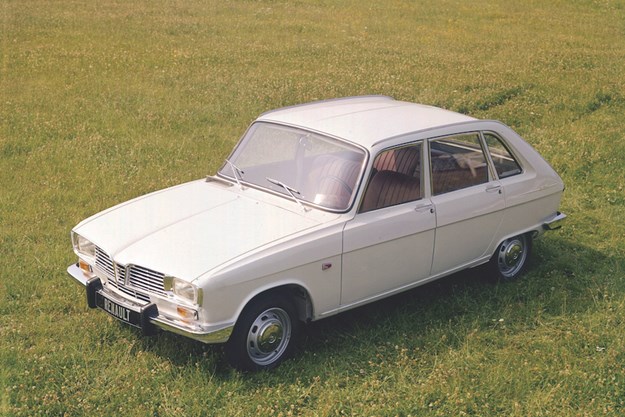 |
| When you're doing your Renault driveshafts, shout it new ends. |
SIGMA SEARCH
Hey Mick. I’ve been offered a Mitsubishi/Chrysler Sigma, but not just a ‘stocker’ – a 2.6lt GSR manual. It was a bit of a special model in its day.
What are your thoughts on checking it out?
Adrian Bennet
Mick says...
If the body, paint and trim are okay, you’re well in front. Body and paint are the big ticket items, while some trim by now may be close to impossible to replace.
As for the engine, the big thing with them is timing chain rattle. There are plenty of people out there who can replace it for you and then, assuming it passes the usual checks, you should be good to go. In any case, the driveline is easy enough to work on.
They were a pretty good package in their day and you’d get a fair bit of interest if you turned up at a coffee and cars in one.
Got a problem? Want some advice on a build or a potential car purchase? Heck, we'll even tackle long distance diagnosis.
Drop Mick a line at uniquecars@primecreative.com.au
Unique Cars magazine Value Guides
Sell your car for free right here
Get your monthly fix of news, reviews and stories on the greatest cars and minds in the automotive world.
Subscribe

.jpg)









